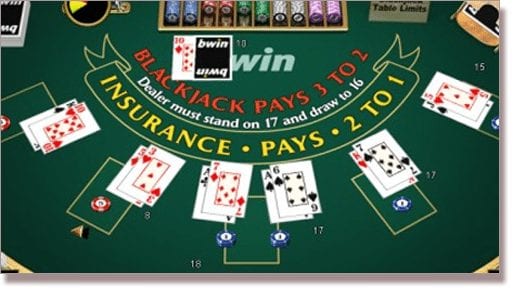Blackjack, also known as 21, is a tactical, skilful and thoroughly entertaining game. It requires and encourages basic strategy and careful judgement, along with the always welcome pinch of luck to win. Because of the emphasis on strategy and the higher level of decision-making, the house edge in twenty-one is considerably lower than in other games based solely on luck. Our decisions affect the overall return to a much greater extent than chance-based games such as Roulette.

The Objective
Blackjack is a casino game with one simple objective: beat the dealer. As a comparing card game between player and dealer, players are not competing against other players. They are simply trying to reach a hand higher than the dealer’s, and equal to or as close to 21 as possible. A standard game has between one and eight 52-card decks (without jokers). Each card has a particular value:
- Numbered Cards 1-10: counted at face value.
- Jack, Queen & King: valued at 10 points each.
- Ace: counts as either one point or 11 points (depending on player’s preference, and can be changed).
The dealer will draw two cards for the player and at least one to him/herself. Depending on the style of twenty-one being played, the dealer will either draw another card to him/herself face down straight away, or wait until each player has played their hand before dealing him/herself another card. After your first two cards are dealt, unless you are dealt a blackjack, you can draw as many cards as you like, one at a time. However, if your total goes over 21 at any-time, you ‘bust’ and lose the round. To win a round, you need to:
- Get a total of 21 points on your first two cards (called a blackjack/natural).
- Get closer to 21 than the dealer’s total without going over.
- Let the dealer draw more cards until their hand exceeds 21 and they bust.
There are several unique rules which apply to the dealer: the dealer cannot double down, split or surrender, and if the dealer exceeds a total of 21 and ‘busts’ and the player has not busted, the players wins. If the dealer does not bust, you must have a higher hand than the dealer’s to win the round; if your hand is lower, you lose.
The following explanations detail two terms which will greatly assist you during a game of 21. For all of the most common terms used in blackjack, you can view our terminology and glossary page.
Split:
When you are dealt two cards of the same value, you can choose to separate those cards to make two individual hands. In order to do so, you will need to place an additional bet equal to your original wager to cover the second hand. The dealer will proceed to draw an additional card for each new hand and we play out both hands in turn.
Depending on the style of 21 you are playing, splitting will come with certain restrictions. One rule which changes from game to game is the continual splitting option, where if we receive two of the same cards and opt to split them, and then receive another card of the same value, we may or may not be able to split again (and again).
Soft-17:
A Soft-17 is a hand which includes an ace card and any other combination of card/s which can give a total of 17. For example, an ace and a six, or an ace, four and two. This hand is called a ‘Soft-17’ because the Ace card can be valued at one or 11, and if we hold this hand and choose to hit, we can not bust with one additional card. If you hit and are dealt a nine for instance, you will count your Ace as a one instead of 11, giving you a total of 16 and the option to hit again. This also applies to any other hand with an ace and gives us the opportunity to improve our hand if the dealer catches a bad card.
However, it can work against us if the dealer has a Soft-17 and hits a four, for example. Each variant of Blackjack will have a specific rule about whether the dealer must hit or stand on a Soft-17. If the dealer must stand on a Soft-17 hand, this decreases the house edge by about 0.2% and this rule should be sought after by players looking to play online.
Achieving Blackjack
Blackjack is obtained when the first two cards dealt are an Ace and a card valued at 10 (10, J, Q or K). For a player, this hand beats any hand the dealer may have, bar blackjack. While some variants of the game will have us paid out immediately if we hit blackjack, no matter what the dealer has, the majority of games hold the rule of a push/tie, where if we and the dealer both acquire blackjack, we don’t lose or win our bet.
Types of Blackjack Games
While there are many variants of this popular game, the basic premise always remains the same: score 21 or as close to 21 as possible. However, there are two distinct types of the game which alter some rules significantly. Here is a brief breakdown of the differences:
Basic American Blackjack
- One of the more flexible Blackjack variants in terms of rules.
- The dealer will not draw an additional card until you have played your hand.
- The dealer must stand on a soft-17.
- You can double down on any hand total.
- You can opt to surrender at any moment during the hand.
Basic European Blackjack
- One of the most used Blackjack versions in land-based and online casinos.
- Two standard decks of cards are used.
- The dealer will not draw a second card until you have played your hand.
- The dealer must hit on soft-17.
- You can only double down on hands with a combined total value of nine, 10 or 11.
- You can only split a hand once a round and only if you are dealt like-valued 10 cards.
- You cannot opt to surrender your hand to salvage half of your bet.
Let’s Get Started
First and foremost, choose how much money you wish to bet on a hand. Betting ranges vary between casinos, but the standard amounts offered are $1, $5, $25 and $100. The game begins once you place your bet. In traditional blackjack, you will then be dealt two face up cards by the dealer, the dealer’s first card will also be placed face up, and the second will be placed face down (the hole card). However, as mentioned above, in many games, the dealer will not draw a second card until players have completed their turns. Additionally, face up blackjack, also known as Double Exposure, deals both dealer cards face up, as the name suggests. Face down blackjack, another version of the game, deals all cards face down.
Once the first two cards are dealt, you have five options available:
- Hit: Take another card.
- Stand: Take no more cards and remain on the total shown by your two cards.
- Split: If your first two cards are of the same value, you can divide them in to two separate hands. The dealer will draw to the first hand and let you play, and then the second hand and let you play it out.
- Double down: Double your bet and draw only one more card to your hand.
- Surrender: Some games offer the option to surrender, allowing us to retrieve half of our bet while the house takes the other half.
Once all players have finished their turns (chosen to stand or busted), the dealer will either turn his/her down card face up, or draw his/her second card (depending on the style), and then hit or stand until reaching a total he/she is required to stay on, or busting. In all formats of the game, the dealer must hit with 16 or less. If the dealer’s hand exceeds 21 points, you win if your hand was not a bust. If the dealer does not bust, then the higher points total between you and the dealer (closest to 21) wins. If you and the dealer both have the same total, your bet is declared a push/stand off in most variants.
You are either paid out or your bet is taken, depending on the outcome of your hand. All the online casinos we recommend have a re-bet option to play again with the same wager as your previous hand.
Insurance
In addition to the main bet, a side-bet called insurance is available. This wager is treated as independent to the main bet. In most games of 21, if the dealer’s up-card is an Ace, you can take the “insurance” bet before the dealer checks or draws his/her hole card. You can wager up to half the value of your main bet for the insurance bet. The reasoning behind an insurance bet is exactly what the name suggests; it insures your original hand and bet against the dealer hitting Blackjack. If we choose to use the insurance option and the dealer’s second card is a card valued at 10, we have successfully covered our inevitable losses.
Obviously, if we are playing a variant of Blackjack which pays us out immediately when hitting Blackjack, there is no need to take the insurance bet, because we have already received our winnings. Insurance pays 2:1 (we receive two dollars for every dollar bet). While it might sound tempting to protect you bet against a dealer’s ace, many knowledgeable gamblers and blackjack players will tell you insurance is a waste of money, to avoid the bet and chance your luck.
House Edge and Payouts
Unlike Roulette, which is entirely a game of chance, blackjack’s outcomes largely depend on the decision-making and strategy of the individual player, making this an ideal game for those who want larger control over their returns. A player who hits blackjack can expect a traditional pay out of 3:2 (if you wagered $100, you receive a profit of $150). All other winning wagers, such if the dealer busts or your total is closer to 21 than the dealer, pay even money at 1:1 (doubling your money).
The house edge will depend on the rule variations of the game. Here are some varying rules which give the house a higher edge:
- Some games offer a 6:5 payout on blackjack, giving the casino an extra 1.39% house advantage. Fewer games have 7:5 and 1:1 payouts. Such payouts are not as common as the 3:2 odds, but they should be avoided at all costs and we should stick with traditional payouts for maximum return. You might be lucky and find a game which has blackjack odds of 2:1, but chances are such games come with other rules which hinder our winning chances.
- If the dealer only lets you double down only with a hand total of nine, 10 or 11 (rather than on any two cards), the casino edge increases to 0.25%, so avoid that version as well.




